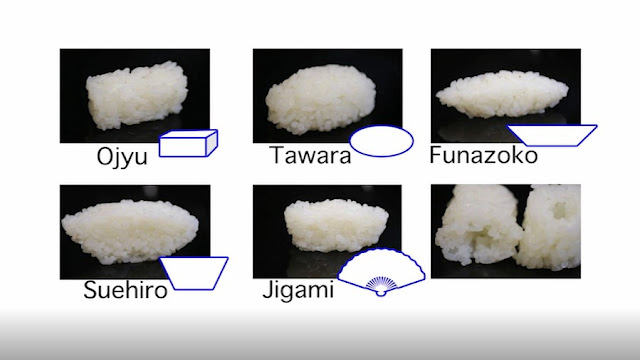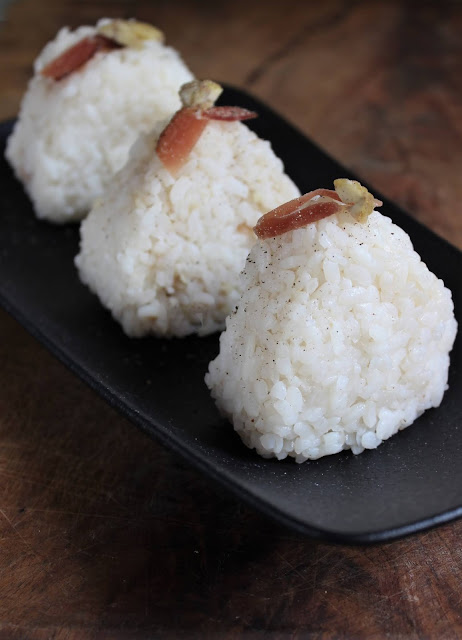Throughout this month of October I like to partecipate in Onigiri Action, a worldwide charity initiative in which various international sponsors donate five school meals to disadvantaged children for each image of onigiri (お に ぎ り or more formally お 握 り) which is published citing the initiative, online or directly on their website on this map.
In recent days I sent photos of some onigiri I already published here in the blog, but I also want to prepare a dedicated one. I immediately thought of a traditional fall Japanese recipe easily transformable into an onigiri: my beloved kuri gohan, 栗 ご は ん, the "chestnut rice" I talked about during one of my seasonal Japanese cooking class.
I liked the correspondence between that dish and macch or mach (both read "mak"), a traditional and ancient chestnut soup typical of Northern Italy (forementioned here) which, according to local products, was prepared with chestnuts and rice, chestnuts and millet or chestnuts and barley... the same three historic cereals of the Japanese diet!
In Piedmont region (where mach means "only, solely" and the soup is also called machët, small mach) chestnuts and rice are cooked in milk; in Valtellina mountains (where macch indicates a thick soup or porridge) if there was no barley or rice, panìco (foxtail millet, setaria italica) was used, a cereal similar to millet which has now almost disappeared; in the nearby Swiss Ticino region, (where official language is Italian and macch is the local word for dry chestnuts) dried chestnuts or their flour were used.
In Lombardy region, mine, macch could be flavoured, when possible, with pork pieces: sometimes not very noble parts such as rinds and butchery cuttings, sometimes with trotters, which once cooked were chopped into the soup, sometimes even just with bones, but on the most fortunate occasions tasty lard or pancetta (italian bacon) appeared.
I hook on to this pork taste to insert an Italian element in the Japanese tradition: if classical kuri gohan authorize some aroma in cooking water and at most a sprinkling of black sesame as additional flavours, in truth onigiri can accommodate everything. They are also called omusubi (お む す び, honorable union), tonjiki (頓 食, literally "fast food" but intended as a "round bite of rice/food") or nigirimeshi (握 り 飯, hand-pressed food/rice): all names show the lack of limits to the ingredients, except for the indispensable rice pressed by hands.
But let's start from basics: today o-nigiri attributes the honorary "o" to a hand-pressed rice ball, the same as nigirizushi (握 り 寿司, literally hand-made sushi), out of Japan the most popular sushi shape together with maki. The substantial difference between nigiri and onigiri is not really in the shape or in the presence/absence of raw fish: it is that the first las rice seasoned with vinegar, salt and sugar, the second has not, it is at most slightly salted or cooked in flawoured water. In any case, nigirizushi traditional rice shapes include only these...
There are traditionally three shapes for onigiri: sankaku gata (三角 型, "triangular in shape", reminiscent of a mountain, in homage to the deities), the best known in the West, tawara gata (俵 型, "shaped like a bale", the cylindrical one in which the rice was collected in the fields to carry it on shoulders), the most used in bento, and maru gata (丸 型, "round in shape"), perhaps the simpler one to be made.
And then fancy onigiri are spreading, reproducing animals, flowers, cartoon characters and so on. But please note: if prepared with seasoned sushi rice, any onigiri loses this qualification and becomes a fancy sushi!
To be an onigiri, however, there is no need to have a filling (called gu, 具, kanji which also means "ingredients"): the other ingredients can also be placed as rice toppings, mixed with the rice before pressing it or not used at all: a small white rice onigiri wrapped in crunchy nori seaweed, for example, is one of my simplest and most profound delicacies!
Nori seaweed is however useful for picking up the onigiri, which can be a snack, a packed lunch or a street food and it was born to be eaten with our fingers; but nori is not mandatory and for this purpose it can be replaced, to taste, from fresh shiso leaves, salad or other things.
There are many traditional fillings/toppings/decorations with ingredients, locations and names that I am not going to list now. Suffice it to say that so far I have not yet found an onigiri like the one I present here, and it seems so strange to me that no one has yet thought about it that I can't wait to be proven wrong!
In summary: chestnuts cooked and perfumed together with rice as for kuri gohan, but then separated to become a hidden filling together with some "very Italian" strips of raw ham, which in Japanese translates パルマハ ム, parumahamu, from Parma ham, aka our prosciutto di Parma (!). Italian ham is umami enough to match all other Japanese flavours and it represents the jummy pork of our Lombard macch.
栗とパルマハムの秋の鬼切 -
KURI TO PARUMAHAMU NO AKI NO ONIGIRI - AUTUMN ONIGIRI WITH CHESTNUTS AND PARMA HAM FILLING
ingredients for about 10 onigiri:
2 Japanese cups Japanese rice (about 8,5 oz)
2 Japanese cups light dashi broth (about 1,3 cups)
8-10 fresh chestnuts (about 3,5 oz)
0,5 oz Parma ham, thinly sliced
1 tbsp sake
1 pinch salt
reel black pepper, to taste
Rinse the rice in fresh water, drain and repeat 3 or 4 times, until the water is clear. Leave it to soak for half an hour in fresh water, then drain and let it rest for about 15 minutes.
Meanwhile boil the chestnuts or... take the shortcut: cut their skin as if to roast them and soak them in warm water for 30 minutes; open the skin slightly, arrange chestnuts in a circle in a microwave dish so that they do not touch each other, add 3 tablespoons of water, cover and cook at 800 W for 10 minutes. Peel them from peel and skin.
Pour the rice into a pot, slightly sink in peeled chestnuts, cover with as much dashi as needed to exceed the rice level by 0,25 inches, then add the sake and a small pinch of salt.
Cover, bring to a boil and, without removing the lid, lower the heat and let it cook for 10 minutes; turn off the heat and, still without opening, let it rest for another 15 minutes.
Leave 2 or 3 cooked chestnuts in the rice, cover again and keep warm. Mash all other chestnuts into a rough and compact puree; cut ham into strips, set aside a dozen of them and add the rest to the puree, then pepper generously.
With wet hands (and a bowl of water next to you, to re-moisten at each step), take about 2 ounches of rice and form a compact ball; form a hollow in the center, place a spoonful of the filling on it, cover with a little more rice and compact everything well.
Give the rice the triangular shape using the space between your thumb and forefinger (or shape it as you prefer), arrange it on a slightly moistened serving dish and prepare other onigiri in the same way.
Decorate the tip of onigiri with a strip of ham and a small piece of chestnut obtained from those kept, sprinkle with freshly ground black pepper and serve.















Commenti
Posta un commento